oracle进阶之分析函数
本博客是自己在学习和工作途中的积累与总结,纯属经验之谈,仅供自己参考,也欢迎大家转载,转载时请注明出处。
http://www.cnblogs.com/king-xg/p/6797119.html
分析函数提供了跨行,多层级聚合引用值的能力,并且可以在数据子集中空值排序粒度。与分组函数不同的是,分析函数并不将结果集聚合为较少的行。
而且分析函数的查询速度比传统sql查询会快很多。
使用分析函数可以在不适用任何自连接的情况下得到一行中聚合和未聚合的值。
示例数据:
-- 创建销售表
create table product_cost(
id number(18) primary key,
year number(4),
month number(2),
pid number(18),
countSum number(18)
); -- 创建产品表
create table product(
id number(18) primary key,
pname varchar(100),
price number(8,2)
); -- 初始化产品表记录
insert into product (pname,price) values('i7-6700K','');
insert into product (pname,price) values('i7-6600K','');
insert into product (pname,price) values('i7-6500K','');
insert into product (pname,price) values('i7-6400K','');
insert into product (pname,price) values('i7-6300K','');
insert into product (pname,price) values('i7-6200K','');
insert into product (pname,price) values('i7-6100K',''); -- 初始化销售表记录
insert into product_cost(year,month,pid,countSum) values(2000,1,1,500);
insert into product_cost(year,month,pid,countSum) values(2000,1,2,630);
insert into product_cost(year,month,pid,countSum) values(2000,1,3,1200);
insert into product_cost(year,month,pid,countSum) values(2000,1,4,320);
insert into product_cost(year,month,pid,countSum) values(2000,1,5,250);
insert into product_cost(year,month,pid,countSum) values(2000,1,6,250);
insert into product_cost(year,month,pid,countSum) values(2000,1,7,350); insert into product_cost(year,month,pid,countSum) values(2000,2,1,1500);
insert into product_cost(year,month,pid,countSum) values(2000,2,2,1630);
insert into product_cost(year,month,pid,countSum) values(2000,2,3,200);
insert into product_cost(year,month,pid,countSum) values(2000,2,4,1320);
insert into product_cost(year,month,pid,countSum) values(2000,2,5,250);
insert into product_cost(year,month,pid,countSum) values(2000,2,6,350);
insert into product_cost(year,month,pid,countSum) values(2000,2,7,520); insert into product_cost(year,month,pid,countSum) values(2000,3,1,520);
insert into product_cost(year,month,pid,countSum) values(2000,3,2,660);
insert into product_cost(year,month,pid,countSum) values(2000,3,3,1900);
insert into product_cost(year,month,pid,countSum) values(2000,3,4,300);
insert into product_cost(year,month,pid,countSum) values(2000,3,5,210);
insert into product_cost(year,month,pid,countSum) values(2000,3,6,210);
insert into product_cost(year,month,pid,countSum) values(2000,3,7,320); insert into product_cost(year,month,pid,countSum) values(2000,4,1,1520);
insert into product_cost(year,month,pid,countSum) values(2000,4,2,1660);
insert into product_cost(year,month,pid,countSum) values(2000,4,3,2900);
insert into product_cost(year,month,pid,countSum) values(2000,4,4,1200);
insert into product_cost(year,month,pid,countSum) values(2000,4,5,980);
insert into product_cost(year,month,pid,countSum) values(2000,4,6,910);
insert into product_cost(year,month,pid,countSum) values(2000,4,7,620); insert into product_cost(year,month,pid,countSum) values(2001,1,1,500);
insert into product_cost(year,month,pid,countSum) values(2001,1,2,630);
insert into product_cost(year,month,pid,countSum) values(2001,1,3,1200);
insert into product_cost(year,month,pid,countSum) values(2001,1,4,320);
insert into product_cost(year,month,pid,countSum) values(2001,1,5,150);
insert into product_cost(year,month,pid,countSum) values(2001,1,6,250);
insert into product_cost(year,month,pid,countSum) values(2001,1,7,350); insert into product_cost(year,month,pid,countSum) values(2001,2,1,1500);
insert into product_cost(year,month,pid,countSum) values(2001,2,2,1630);
insert into product_cost(year,month,pid,countSum) values(2001,2,3,200);
insert into product_cost(year,month,pid,countSum) values(2001,2,4,1320);
insert into product_cost(year,month,pid,countSum) values(2001,2,5,250);
insert into product_cost(year,month,pid,countSum) values(2001,2,6,350);
insert into product_cost(year,month,pid,countSum) values(2001,2,7,450); insert into product_cost(year,month,pid,countSum) values(2001,3,1,520);
insert into product_cost(year,month,pid,countSum) values(2001,3,2,660);
insert into product_cost(year,month,pid,countSum) values(2001,3,3,1900);
insert into product_cost(year,month,pid,countSum) values(2001,3,4,300);
insert into product_cost(year,month,pid,countSum) values(2001,3,5,180);
insert into product_cost(year,month,pid,countSum) values(2001,3,6,210);
insert into product_cost(year,month,pid,countSum) values(2001,3,7,320); insert into product_cost(year,month,pid,countSum) values(2001,4,1,1520);
insert into product_cost(year,month,pid,countSum) values(2001,4,2,1660);
insert into product_cost(year,month,pid,countSum) values(2001,4,3,2900);
insert into product_cost(year,month,pid,countSum) values(2001,4,4,1200);
insert into product_cost(year,month,pid,countSum) values(2001,4,5,980);
insert into product_cost(year,month,pid,countSum) values(2001,4,6,910);
insert into product_cost(year,month,pid,countSum) values(2001,4,7,620);
数据展示:

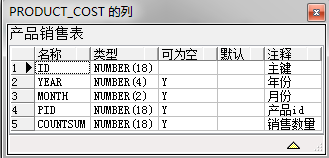
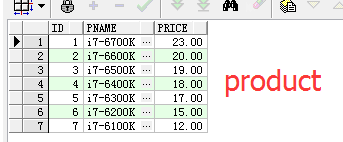

-- 常用分析函数列表 . leg -- 访问一个分区或结果集中的前一行
. lead -- 访问一个分区或结果集中的后一行
. first_value -- 访问一个分区或结果集中的第一行
. last_value -- 访问一个分区或结果集中的最后一行
. nth_value -- 访问一个分区或结果集的指定行
. rank -- 将数据行值按照排序后的顺序进行排名,在有并列的情况下排名值将被跳过
. dense_rank -- 将数据行值按照排序后的顺序进行排名,在有并列的情况下也不会跳过排名
. row_number -- 对行进行排序,并为每一行赋予一个随机且唯一的编号
. ratio_to_report -- 计算报告中值的比例
. percent_rank -- 将计算得到的排名标准化为0到1之间的值
. ntile -- 对每一个分区进行再分组,并为每一个分组提供一个唯一标识(仅在本分区中唯一),每组的数据行数为指定值,但每组之间最多相差一个数据行
. listagg -- 将来自不同行的列值转化为列表格式
分析函数的组成:
(1) 指定列或范围 解释: 分析函数一般带两个括号,第一个就是指定该函数所作用的列
(2) 分组 解释: 1. 将数据分区,关键字 partition by,有点像group by,但却有很大不同,group by分组后的列只存在唯一值,不存在等同的值(就像是将数据分类,只显示类型名称一样),而partition by 是将数据原封不动根据后面给的字段进行划分边界形成分区(即每个分区都存在边界)
2. group by 针对整个表或数据集,partition by 针对于每一行的记录
(3) 排序 解释: order by就是排序
(4) 窗口控制 解释: 1.控制边界的范围,默认是 rows between unbounded preceding and current row(起始边界到当前行),rows between unbounded preceding and unbounded following(整个分区),以及自定义的边界范围 rows between [number] preceding and [number] following(起始边界是该行的前xx行结束边界是该行的后xx行)
2.在没有分区的情况的,窗口控制会在一定程度上起到分区作用
举例:
1. (leg函数) 查询每一个产品的月销售总额与前一个月的对比
select pc.id as id, pc.year as year,pc.month as month,p.pname as pname,p.price as price,pc.countsum as countSum,(pc.countsum*p.price) as currentAmt,lag(pc.countsum*p.price,,pc.countsum*p.price) over(partition by year,pc.pid order by year,month,pid) as beforeAmt
from product_cost pc
left join product p on p.id=pc.pid
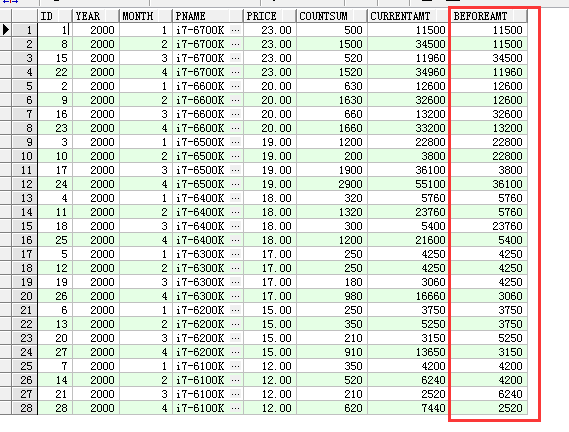
注意: leg分析函数中的字段区域,不能用别名(不能写"currentAmt"只能写"pc.countsum*p.price"),会报标识符无效的异常,除非用子查询,就能用别名,原因:select 同一层级,解析在同一时间,oracle是认识别名标注的字段,除非在解析分析函数之前,即子查询
2. (lead函数),同上就是查询的方向由向上查询改成向下查询而已。
3. (first_value函数) 统计每个月月销量第一的产品
select pc.id as id, pc.year as year,pc.month as month,p.pname as pname,p.price as price,pc.countsum as countSum,(p.price*pc.countsum) as currentAmt,first_value(p.price*pc.countsum) over(partition by year,month order by year,month,p.price*pc.countsum DESC) as sum
from product_cost pc
left join product p on pc.pid=p.id
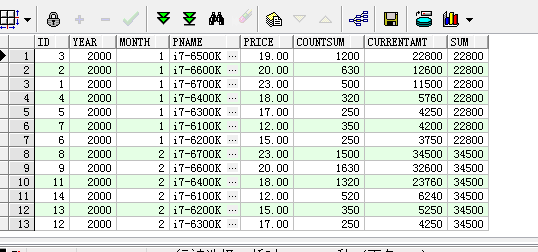
聚合函数也可以应用到里面,上面的sql可以换成下面的
select pc.id as id, pc.year as year,pc.month as month,p.pname as pname,p.price as price,pc.countsum as countSum,(p.price*pc.countsum) as currentAmt,max(p.price*pc.countsum) over(partition by year,month order by year,month,p.price*pc.countsum DESC) as sum
from product_cost pc
left join product p on pc.pid=p.id
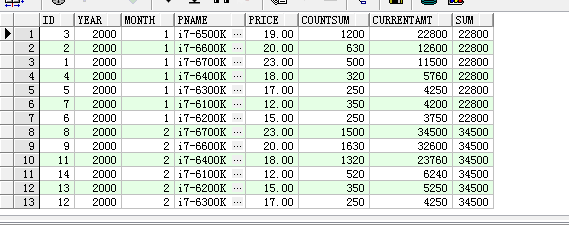
4. last_value函数,同上,查询分区中排序或不排序的最后一条记录
5. nth_value函数,查询指定行的记录,比如: 计算当月销量第二名的产品销量总额
select pc.id as id, pc.year as year,pc.month as month,p.pname as pname,p.price as price,pc.countsum as countSum,(p.price*pc.countsum) as currentAmt,nth_value(p.price*pc.countsum,) over(partition by year,month order by year,month,p.price*pc.countsum DESC rows between unbounded preceding and unbounded following) as sum
from product_cost pc
left join product p on pc.pid=p.id

6. rank函数,排名函数之一,特点:同名(排名)跳排,排名依据为order by 后的字段值,例子:对每个月的产品进行排名,依据月销量进行排名
select pc.id as id, pc.year as year,pc.month as month,p.pname as pname,p.price as price,pc.countsum as countSum,rank() over(partition by year,month order by pc.countsum DESC) as orderName
from product_cost pc
left join product p on pc.pid=p.id
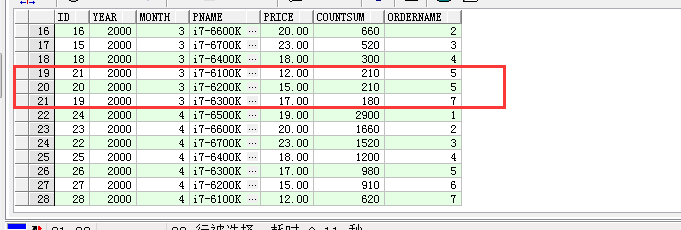
7. dense_rank函数,排名函数之一,特点:同名不跳排,排名依据order by后的字段值,例子:对每个月的产品进行排名,依据月销量进行排名
select pc.id as id, pc.year as year,pc.month as month,p.pname as pname,p.price as price,pc.countsum as countSum,dense_rank() over(partition by year,month order by pc.countsum DESC) as orderName
from product_cost pc
left join product p on pc.pid=p.id
小结: rank函数和dense_rank函数的相同点,排序的字段值相同,则排名相同,唯一不同点就是rank会跳排,根据相同值的数量而定,跳排数为相等值的数量-1,dense_rank函数不跳排,无论存在多少相等的值

8. row_number函数,为数据行分配一个唯一标识,举例:
select pc.id as id, pc.year as year,pc.month as month,p.pname as pname,p.price as price,pc.countsum as countSum,row_number() over(partition by year,month order by pc.countsum DESC) as orderName
from product_cost pc
left join product p on pc.pid=p.id
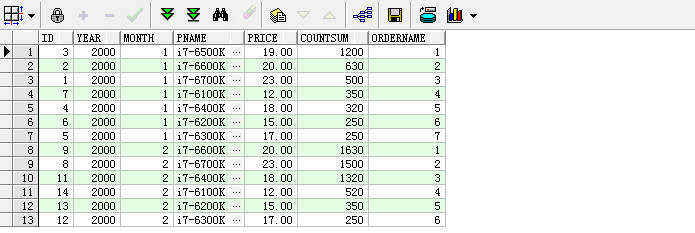
9. ratio_to_report函数,计算值在该分区或整个表或数据集中所占比例
select pc.id as id, pc.year as year,pc.month as month,p.pname as pname,p.price as price,pc.countsum as countSum,trunc(*ratio_to_report(p.price*pc.countsum) over(partition by year,month),)||'%' as proportion
from product_cost pc
left join product p on pc.pid=p.id
order by year,month,p.price*pc.countsum DESC

注意: 在ratio_to_report函数中,不能使用排序,只能在外层使用order by
10. percent_rank函数,计算得到的排名,且排名值为0-1之间的数(排名值越低,排名越高)
select pc.id as id, pc.year as year,pc.month as month,p.pname as pname,p.price as price,pc.countsum as countSum,percent_rank() over(partition by year,month order by countsum DESC) as proportion
from product_cost pc
left join product p on pc.pid=p.id
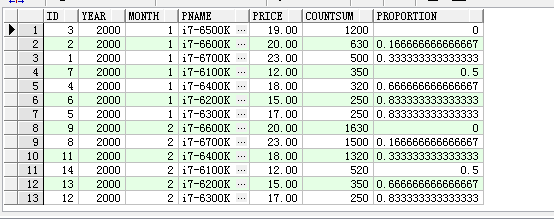
11. ntile函数,特点:方便将有问题的数据放到一个统一的容器中,举例:领导发话说客户不想看到这些销量低于300的数据记录
select pc.id as id, pc.year as year,pc.month as month,p.pname as pname,p.price as price,pc.countsum as countSum,ntile() over(partition by year,month order by countsum DESC) as proportion
from product_cost pc
left join product p on pc.pid=p.id

12. listagg函数拥有将列值转化成列表格的能力
select listagg(p.pname,',') within group (order by p.id) as str
from product p

// 结果: i7-6700K,i7-6600K,i7-6500K,i7-6400K,i7-6300K,i7-6200K,i7-6100K
顺便小结一下,字符串的拼接方法:
(1). 自定义函数拼接字符串
(2). "||" 符合进行拼接
(3). wmsys.wm_concat函数拼接字符串
(4). listagg函数拼接字符串
oracle进阶之分析函数的更多相关文章
- 利用Oracle内置分析函数进行高效统计汇总
分析函数是Oracle从8.1.6开始引入的一个新的概念,为我们分析数据提供了一种简单高效的处理方式.在分析函数出现以前,我们必须使用自联查询,子查询或者内联视图,甚至复杂的存储过程实现的语句,现 ...
- Oracle 中的分析函数
Oracle常用分析函数介绍(排名函数+窗口函数) 2014年11月30日 ⁄ 数据库 ⁄ 共 3903字 ⁄ 暂无评论 ⁄ 阅读 7,772 次 评级函数 常见评级函数如下: RANK():返回数据 ...
- 【Oracle】oracle之listagg分析函数
oracle分析函数——listagg篇 (1)使用listagg将多行数据合并到一行 例表: select deptno, ename from emp order by deptno, ename ...
- oracle累积求和分析函数sum over的使用
oracle sum()over函数的使用 over不能单独使用,要和分析函数:rank(),dense_rank(),row_number()等一起使用. over函数的参数:over(partit ...
- Oracle进阶研究问题收集
1. buffer busy waits http://www.itpub.net/thread-1801066-1-4.html 2. 深入理解oracle log buffer http://ww ...
- 求学生单科流水表中单科最近/最新的考试成绩表的新增可行性方案 使用Oracle提供的分析函数rank
在 https://www.cnblogs.com/xiandedanteng/p/12327809.html 一文中,提到了三种求学生单科最新成绩的SQL可行性方案,这里还有另一种实现,那就是利用分 ...
- oracle进阶之connect by笔记
本博客是自己在学习和工作途中的积累与总结,仅供自己参考,也欢迎大家转载,转载时请注明出处. http://www.cnblogs.com/king-xg/p/6794562.html 如果觉得对您有帮 ...
- oracle 进阶之model子句
本博客是自己在学习和工作途中的积累与总结,仅供自己参考,也欢迎大家转载,转载时请注明出处. http://www.cnblogs.com/king-xg/p/6692841.html 一, mode ...
- Oracle row_number() over() 分析函数--取出最新数据
语法格式:row_number() over(partition by 分组列 order by 排序列 desc) 一个很简单的例子 1,先做好准备 create table test1( id v ...
随机推荐
- Spring笔记③--spring的命名空间
p:命名空间: xmlns:p="http://www.springframework.org/schema/p" 作用:简化在xml配置bean的属性 在<bean> ...
- b1
组长:吴晓晖 过去两天完成了哪些任务: 代码重构进行中,界面,预计两个beta单位完成 展示GitHub当日代码/文档签入记录 接下来的计划 更加人性化的推荐算法 还剩下哪些任务 有哪些困难 有哪些收 ...
- android 的helloworld没跑起来 原因
<manifest xmlns:android="http://schemas.android.com/apk/res/android" package="com. ...
- (小组)第六次作业:NABCD模型分析。产品Backlog。
NABCD模型分析: NABCD模型分析 1.N——need需求 随着时代的进步,人们生活水平的提高,现在手机的普及率已经非常高了,而且现在的家长很多时候会忙于工作,很少会花时间出来给自己读小学的孩子 ...
- 小学四则运算结对项目报告【GUI】
写在前面 这次的结对项目我做了很长时间,感触也很多.在这次项目中我使用了Java GUI作为和用户的交互方式,但是在上Java课的时候我对GUI和事件驱动这里并没有学的多好,可能是当时对编程还没有什么 ...
- PTA计算平均值(一波三折)
PTA计算平均值( 一波三折) 现在为若干组整数分别计算平均值. 已知这些整数的绝对值都小于100,每组整数的数量不少于1个,不大于20个. 输入格式:首先输入K(不小于2,不大于20).接下来每一行 ...
- XLSReadWriteII5使用示例
之前一直是使用XLSReadWriteII4,今天更新到XLSReadWriteII5,测试了一下,发现一些操作变化比较大,现将XLSReadWriteII5的使用示例写一下,以下是代码和生成的exc ...
- 我所理解的Delphi中的数组类型
数组可以使Object Pascal所拥有的任何数据类型,数组是一些数值的简单集合. var MyArray: ..] of Integer; { 声明一个数组包括5个整数数值} b ...
- D3.js 入门学习(二) V4的改动
//d3.scan /* 新的d3.scan方法对数组进行线性扫描,并根据指定的比较函数返回至少一个元素的索引. 这个方法有点类似于d3.min和d3.max. 而d3.scan可以得到极值的索引而不 ...
- vue & keep-alive & activated
vue & keep-alive & activated vue 生命周期 钩子函数 缓存 http://www.cnblogs.com/nekoooo/p/6442077.html ...
